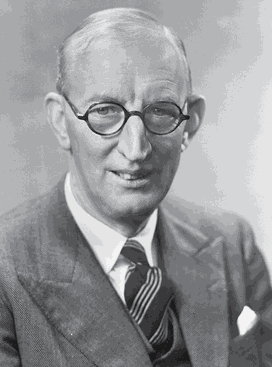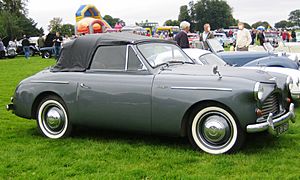Leonard Lord facts for kids
Quick facts for kids
Leonard Lord, 1st Baron Lambury
|
|
|---|---|
 |
|
| Born | 15 November 1896 |
| Died | 13 September 1967 |
| Nationality | British |
| Occupation | Automobile executive |
| Known for | Co-founding and leading British Motor Corporation |
Leonard Percy Lord, 1st Baron Lambury (born November 15, 1896 – died September 13, 1967) was a very important leader in the British car industry. He helped shape how cars were made and sold in the UK for many years. He was also honored with the title Knight Commander of the British Empire (KBE) and later became a Baron.
Contents
Early Life and School Days
Leonard Percy Lord was born on November 16, 1896. He was the youngest child in his family. His father, William Lord, lived in Coventry.
Leonard went to Bablake School in Coventry. This school was special because it had a full workshop for carpentry and a working forge. This meant students could learn practical skills. Leonard did very well in school. Like many students there, his school fees were paid by the Coventry Education Committee.
He left school at 16 after his father passed away. He used the technical skills he learned at Bablake to get his first job. He worked as a jig draughtsman at a company called Courtaulds.
Building a Car Career
Leonard Lord moved to different engineering companies after school. He worked at Vickers and then at Coventry Ordnance Works. This was a factory that made weapons during the First World War.
After the war, around 1918, he worked at a factory that made Daimler car engines. In 1923, he joined Morris Motors Limited. Here, he helped make the car production process much more efficient. He found ways to make every step of building a car work better.
In 1927, Morris Motors bought Wolseley Motors Limited. Leonard was sent to Wolseley to update their factories and equipment. He was very good at this job.
Rising Through the Ranks
By 1932, Leonard Lord became the General Manager at Morris Motors. He worked from their factory in Cowley. He was so effective that in 1933, William Morris (who later became Lord Nuffield) made him the Managing Director of Morris Motors.
By 1934, William Morris was a very rich man. His business empire was known as the Nuffield Organization. Leonard Lord resigned from Morris Motors in August 1936. In 1937, Lord Nuffield asked Leonard to manage a special fund. This fund helped areas in economic trouble.
However, Leonard Lord wanted to get back into the car industry. After some disagreements with William Morris, he left to join Morris's main competitor. This was the Austin Motor Company.
Leading the Austin Motor Company
When Leonard Lord joined Austin in 1938, Herbert Austin was looking for someone to lead his company. Herbert Austin's only son had died during the war. Leonard Lord was chosen to manage the company.
Herbert Austin passed away in 1941. After this, Leonard Lord became the most powerful person at the Austin Motor Company. During the Second World War, Austin stopped making cars for regular people. Instead, they made vehicles for the military. This included ambulances and other government vehicles.
After the war, in 1946, Austin started making cars for the public again. Leonard Lord became the Chairman of Austin. He worked hard to make the company grow. He set up car factories in many countries. These included Canada, Australia, Argentina, South Africa, and Mexico.
In 1954, he was given a high honor. He was appointed a Knight Commander of the Order of the British Empire (KBE).
Forming British Motor Corporation
Leonard Lord continued to make big changes in the car industry. In 1952, Austin merged with his old employer, the Nuffield Organization. This was a huge merger! Austin, led by Lord, was the stronger partner in this deal.
This merger created the British Motor Corporation (BMC). Leonard Lord became the president of this new, large company. On March 26, 1962, he was given a special title. He became Baron Lambury, from Northfield in the County of Warwick. This meant he was now a member of the British peerage.
Later Years and Legacy
Leonard Lord passed away in 1967 at the age of 70. His death happened during talks that eventually led to the creation of British Leyland, another big car company.
H. Brian Cottee, an editor for Commercial Motor magazine, wrote about Lord after he died. He said Lord was a "production engineer" who was very skilled. He called him "one of the great engineer-administrators of the motor industry." Cottee described Lord as tough and capable, but also having a sense of humor and sometimes being humble.
Lord's Impact on the Car Industry

Leonard Lord helped modernize how cars were made at factories like Cowley and Longbridge. This made British cars more competitive in markets around the world. He also helped Britain export many cars after the war, which was important for the country's economy.
He brought together two major rival car companies to form BMC. However, it was sometimes hard to make sure both parts of the company worked together smoothly.
Some people, like Graham Searjeant, a financial editor, have said that Lord lacked vision. They also blamed some problems at the Longbridge factory on his successor, George Harriman.
However, Martyn Nutland, who wrote a book about Lord, disagrees. He believes Lord handled the challenges of his time very well. It was Leonard Lord who convinced Alec Issigonis to rejoin BMC. Issigonis then designed the Mini and the 1100. These became two of Austin/BMC's most successful cars ever. Lord gave Issigonis the freedom to create these revolutionary cars. Gillian Bardsley, an archivist, also credits Lord with the idea that BMC needed completely new car designs to stay competitive in the 1960s.
Personal Life
Leonard Lord married Ethel Lily Horton in 1921. They had three daughters together.
Lord, who became Baron Lambury in 1962, died in September 1967. He was 70 years old. Since Lord Lambury did not have any sons, his title as Baron ended when he died.


